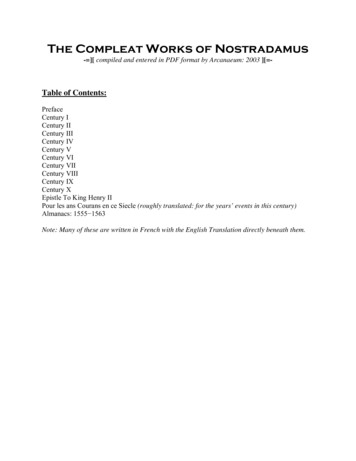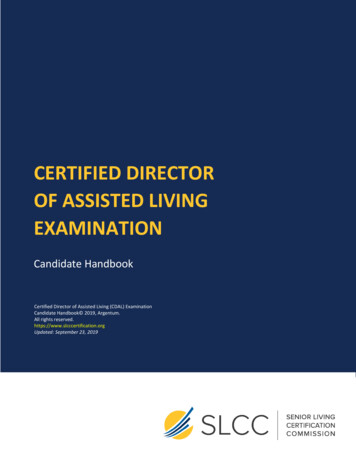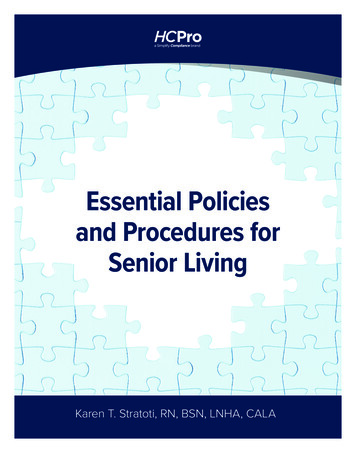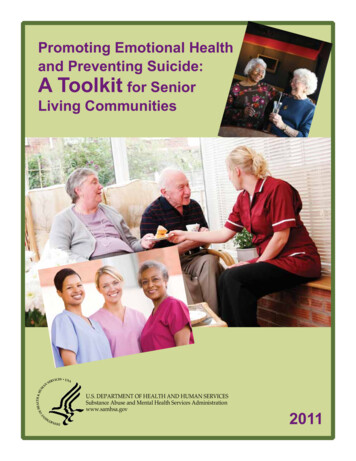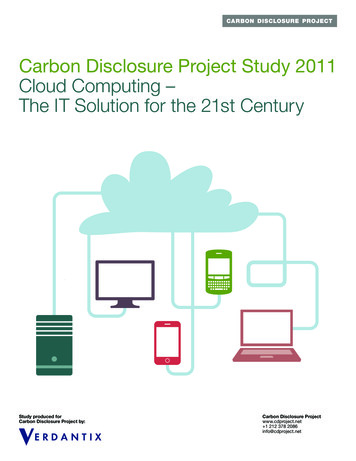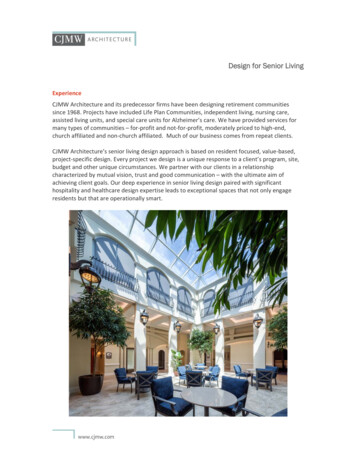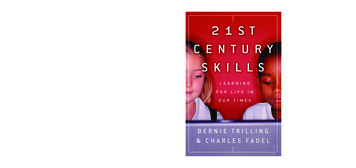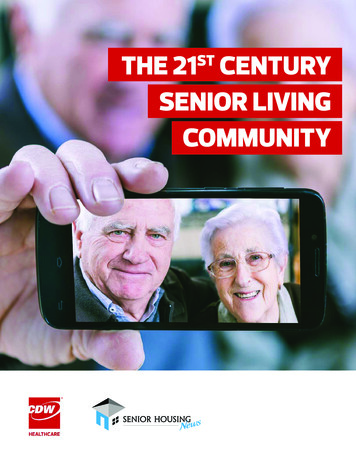
Transcription
THE 21 CENTURYSENIOR LIVINGCOMMUNITYST
BUILDING A PLATFORM FORTHE FUTURE OF SENIOR LIVINGDear Senior Housing Readers,In a profession where the care of your residents takes precedence over all things, it is hard to imagine how technologycould actually empower you to have more time to care for your residents. At CDW, we liken it to the years when BabyBoomer children began crowding the classrooms and there were not enough teachers to support the various disabilitiesand diverse learning styles of the students—schools looked to technology to re-imagine how they were teaching andtransforming the learning experience. CDW was there to build the infrastructure and technology solutions to introduceand design digital classrooms across the country—a concept called the “21st century classroom.”Senior housing is at this very crossroads today. The lack of technology literacy and the growing shortage of caregiversare pushing senior housing to view technology in a new way—as a vehicle to support a growing tech savvy populationand optimize workflow to do more with less. And once again, CDW is here to scale, build and transform the experienceof a “person-centered” profession with technology. The playbook is similar—same goals, different players. Innovationand applications need to be built on a solid foundation of best-in-class infrastructure. Senior Housing needs a trustedadvisor to re-imagine senior care and build the “21st century community.”CDW’s VP of Healthcare, Bob Rossi, and I started this conversation when education was starting to roll out one-to-onecomputing—an initiative where schools provide a device for every enrolled student. At that time, I was working withlarge senior care providers on how to engage and empower residents with technology in my role as National Director ofInnovation and Resident Technology. CDW Healthcare was the partner who helped me build scalable solutions that madea difference with my residents. It was not about the “new shiny” technology, but rather technology solutions that drovemeaning and purpose by connecting loved ones to families and bridging the digital world to an analog and paper-onlysenior living community.Our view on technology is not as a replacement to skilled associates and caregivers in the communities, but to providethe platform that allows senior living operators and care staff to focus on more engagement, and add more time for theirresidents. Most importantly, technology should enable you to make the best difference for every resident with whomyou are entrusted.The assortment of technology stories, wisdom and solutions that follow is here to help you imagine the possibilitiesof how technology can begin to transform your senior care community. We dare you to start re-imagining what yourcommunity should look like for the 21st Century senior care.Thank you for allowing us to share,Ginna BaikStrategic Business Development ExecutiveCDW-HealthcareTHE 21ST CENTURY SENIOR LIVING COMMUNITY2
CONTENTS2Building a Platform for the Future of Senior Living4About CDW and Senior Housing News5Key Takeaways6The 21st Century Senior Living Community814THE VISIONMapping the 21st Century Senior Living CommunityTHE APPLICATIONIncorporating Technology for Residents and Staff30Laying the Groundwork for Technology Installation35Technology in the 21st Century39Bringing Senior Living into the 21st CenturyTHE FOUNDATION
ABOUTCDWCDW is a leading multi-brand technology solutionsprovider to business, government, education andhealthcare organizations in the United States, Canadaand the United Kingdom. A Fortune 500 company withmultinational capabilities, CDW was founded in 1984 andCDW Healthcare is focused exclusively on serving theemploys approximately 8,500 coworkers. Our broadhealthcare marketplace. The dedicated healthcare teamarray of offerings range from discrete hardware andleverages the expertise of CDW solution architectssoftware products to integrated IT solutions such asto deliver best-in-class solutions from data centermobility, security, cloud, data center and collaboration.infrastructure through the point of patient care.ABOUTSENIOR HOUSING NEWSSenior Housing News (SHN) is the leading source ofnews and information about the senior housing industry.With a national reach of more than 30,000 professionals,SHN readership includes senior housing operators,developers, banking institutions, real estate investmenttrusts, private equity firms and service providers thatSHN provides a cutting-edge and targeted platformcater to the industry.unlike any other publication, giving you the opportunityto reach decision-makers every day.THE 21ST CENTURY SENIOR LIVING COMMUNITY4
KEYTAKEAWAYSThe 21st century senior living community may seem like a far-off dream, but with a focused plan and the properframework, it’s entirely within reach. Here are a few key takeaways to keep in mind as you push to bring your communityinto the 21st century.1The 21st century senior living community is not Grandma’s nursing home.The long-standing notion of drab, dreary, old-fashioned nursing homes as places where Grandma and otherseniors live is a thing of the past. The 21st senior living community stands as a thriving tech ecosystem,where devices interact with one another to enhance resident and staff experiences—and this is whatproviders should strive for.2Technology must be implemented with purpose.In order to achieve success as a 21st century senior living community, providers must completelyunderstand how technology products work, where they fit into their facilities and how they would benefitresidents. This requires determining company initiatives, strategic planning and appropriate budgets, toachieve both individual and all-encompassing goals.3Be sure to consider the many facets of the 21st century senior living community.Providing residents with tablets and calling it a day isn’t the way to reach 21st century senior livingcommunity status. Rather, there are many areas in which providers need to concentrate their efforts toimprove the resident experience and operational efficiencies, including wellness and health care, residentcommunication, safety and security, entertainment and staffing.4Infrastructure comes first, no matter what.Senior living providers can have all of the latest and greatest technology, but if they don’t have the properinfrastructure to support it, their efforts will certainly fall short. Installing a blend of hardware, software,networks and IT departments allows providers the means to launch new technology initiatives, but it allstarts with the needs of the community itself—and depends largely on what future residents will demand.5Remain flexible—there’s no one single formula for 21st century senior living communities.Considering the needs of today’s senior living residents and thinking ahead to the desires of future residentsare challenges that all providers face in implementing technology. To truly achieve the distinction of 21stcentury senior living communities, operators need to plan for change and create environments that canquickly adapt to new technologies.THE 21ST CENTURY SENIOR LIVING COMMUNITY5
THE 21ST CENTURY SENIORLIVING COMMUNITYThe turn of the century brought with it tremendous innovation in technology.The Internet has become a staple for all ages, and seemingly everything has gone mobile as information is shared oversmartphones and other devices. Artificial intelligence is no longer a far-fetched idea—rather, it’s an increasingly plausiblesolution for some of the world’s biggest problems and daily activities.In the 21st century, it’s as though nothing can be completed without some form of technology involved.“Technology is the hallmark of everythingthat we do in reality,” says Majd Alwan, seniorvice president of technology and executivedirector of the LeadingAge Center for AgingServices Technology (CAST). “Technologyhas crept up on all of us and has become partof the fabric of our daily lives, even if we werereluctant at first.”The rate of innovation and the constantintroduction of new devices has leftthe senior living industry scrambling tokeep up. Paper job applications and careis the hallmark of“ Technologyeverything that we do in reality.Technology has crept up on all of usand has become part of the fabricof our daily lives, even if we werereluctant at first.”Majd AlwanSenior Vice President of Technology and ExecutiveDirector of the LeadingAge Center for AgingServices Technology (CAST)documentation don’t cut it when it comesto recruiting and retaining millennial staff, just as bingo won’t keep residents engaged, and once-a-day check-ins don’tsuffice to maintain their optimal health and wellness.Senior living needs to make the ultimate push into the 21st century. With that push, providers can't ignore technology.“The market is going to demand it, and not only the residents, but their families, their children, their grandchildren andmillennial caregivers,” says Dean Maddalena, President of studioSIX5, a Austin, Texas-based senior living interior designfirm. “It’s part of everyday life, and we want these communities to mimic everyday life as much as possible.”Currently, 61% of the Silent Generation—people born between 1925 and 1945—uses the Internet, according to 2016data from the Pew Research Center, which comprises the majority of senior living residents today. Internet use amongolder and younger baby boomers, at 78% and 83% respectively, offers a glimpse of what future senior living residentsTHE 21ST CENTURY SENIOR LIVING COMMUNITY6
will expect, and nearly universal Internet adoption among their adult children paint an even clearer picture of whatcommunities need to provide.The oldest baby boomers turned 70 in 2016,according to AARP, meaning more and moremembers of this approximately 76.4-million-INTERNET USERS BY GENERATIONstrong population will be reaching retirementSource: Pew Research Centerage and considering senior living options in theyears ahead, and they’ll bring their differentexpectations when exploring their options.Industry players must strive to create avibrant 21st-century senior living communityin order to remain competitive amid changesin the health care landscape and on X(35–50)92%Younger Boomers(51–59)83%Older Boomers(60–69)76%From electronic health records (EHRs) andsmart homes to virtual reality and wearables,the senior living industry is poised for aSilent(70–87)61%dramatic shift.But Wi-Fi and individual devices alone won’tcut it for senior living providers. The community of the future is not grandma’s nursing home, and technology here andthere will not suffice. Rather, the 21st-century senior living community is a fully functioning tech ecosystem wheredevices communicate with one another to improve the lives of staff and residents, largely hinging on the Internet ofthings (IoT), where all devices and communications are interconnected. It’s a complete reimagination of what seniorliving entails, and it’s poised to change the industry as it stands today.THE 21ST CENTURY SENIOR LIVING COMMUNITY7
THE VISION:Mapping the 21stCentury SeniorLiving Community
THE VISION:MAPPING THE 21ST CENTURYSENIOR LIVING COMMUNITYThe 21st century senior living community has many components, and defining it varies greatly by provider andperspective.Overall, the vision largely deals with integratingtechnologies to: Increase efficienciesOptimize workflowsAdhere to current residents’ desiresPrepare for future populationsAnother crucial aspect of the 21st century senior livingcommunity is the Internet of things, and how it focusesspecifically on connections—from staff to resident, residentto resident, resident to family and friends, resident toOhio Living, it’s trying“ Forto meet seniors where theyare today, but also bringingthings in to provide for thenext generation of seniors.It’s not leaving anyonebehind, but also trying tolook forward.”caregiver and more. Today, the proliferation of interactivedevices geared toward senior care have made this level ofconnectivity even more achievable.Joyce MillerChief Information Officer for Ohio Living“For Ohio Living, it’s trying to meet seniors where theyare today, but also bringing things in to provide for the next generation of seniors,” says Joyce Miller, Chief InformationOfficer for Ohio Living. “It’s not leaving anyone behind, but also trying to look forward.”That means planning for change by creating environments that can adapt quickly to accommodate new technologies,according to studioSIX5’s Maddalena.“To me, it’s going to be more about flexibility, because change is accelerating,” he says. “Next year, you don’t know whateveryone is going to want.”Senior living providers will also be called on more and more to deliver on-demand, customized experiences for thepeople they serve, according to Kari Olson, chief innovation and technology officer for Front Porch and President of theTHE 21ST CENTURY SENIOR LIVING COMMUNITY9
Front Porch Center for Innovation and Wellbeing. This puts pressure on the traditional community model.“In terms of how we operate, it’s going to be a challenge for us to transform our businesses and what we can do ondemand,” Olson says. “Technology has a huge role to play in enabling and supporting that.”Additionally, 21st century senior housing should be a place where technology fosters shared experience and an overallsense of community. And senior living of tomorrow will feature increasingly integrated technology, Olson says.“What I see going forward is the integration into one overall system of services and supports for people,” she says. “Theend point is making sure the customers are connected to the right people at the right time, in a personalized way.”No matter how tech savvy seniors are today or will be in the future, though, it’s important to consider the sheer amountof downsizing that occurs time and again in the aging process, as has happened with all other generations. That’s not tosay they won’t want technology at all, but it’s unlikely that they’ll want a plethora of gizmos and gadgets at their disposal,says Suzanne Viox, executive director of Link-age Connect. And anything that is implemented should be as unobtrusiveas possible.Beyond the resident experience, there are business considerations to take into account, and the role technology can playin establishing senior living as a viable player in the health care industry as a whole.“The 21st century seniors housing community is based on the idea that, whether we want to admit it or not, seniorhousing will become more and more a part of the post-acute continuum of care,” says Charles Turner, president ofPinPoint Senior Living, a developer and owner with 13 senior living properties in four states, and its operating company,THE 21ST CENTURY SENIOR LIVING COMMUNITY10
LifeWell Senior Living. “We will become a de facto partner with hospital systems, other post-acute providers and themedical community. As an industry, we need to provide more information to the marketplace to show how we care forour residents.”As a result, PinPoint looks to invest in technologies that show a quantitative outcome depicting efforts to improvequality of life for residents. That information then becomes a powerful tool as PinPoint communicates and forgesrelationships with the outside world.Likewise, Steve Hopkins, former COO of Evangelical Homes of Michigan and president of Curo Technologies, seestechnology as a means of being proactive rather than reactive in terms of seniors’ health care, by collecting data abouttheir day-to-day activities.“We’re trying to gather important information about how people are doing when no one is there,” he says. “It’s the recipefor future efficiency and cost reduction.”Senior living has historically lagged behind other industrieswhen it comes to tech adoption—as of August 2015, 91% ofproviders had a wireless infrastructure on campus, accordingTABLET USE BY GENERATIONto a survey of almost 180 senior living CFOs from Chicago-Source: Pew Research Centerbased specialty investment bank Ziegler. But that percentagerepresents a recent sea change: The same study found that thepercentage of communities that invested in Internet connectivitydoubled between 2012 and 2013. And the quality and depth ofthe Wi-Fi offered may very well fall behind what’s needed in theMillennials(18–34)52%Generation X(35–50)55%communities.Although seniors have typically been associated with lack ofinterest in tech adoption, older adults who are coming of agefor retirement will expect it. Only 25% of those in the silentgeneration use smartphones, as compared with 46% of olderbaby boomers and 59% of younger baby boomers. Tablet use isYounger Boomers(51–59)35%Older Boomers(60–69)Silent(70–87)41%29%slightly more scattered, at 29% for the silent generation, 41% forolder boomers and 35% for younger boomers.Moving forward, the senior living sector must think ahead andbring communities up to speed if they want to remain competitive now and in the future.“It’s really waking up and realizing where the world is heading,” says Chris Guay, president and CEO of Vitality SeniorLiving. “It’s important to adapt to provide something seniors really want.”THE 21ST CENTURY SENIOR LIVING COMMUNITY11
What exactly they want, though, is the ever-persistent question. It requires not only paying attention to what currentsenior living residents desire in terms oftechnology, but also what prospective residentsmight be seeking, as well as those who willSMARTPHONE USE BY GENERATIONconsider senior living in five, 10 and even 20 years.Source: Pew Research CenterIt also means looking outside the senior careindustry for the latest technology for the latesttechnology trends in the hospitality, restaurantand retail sectors.In any case, providers are taking variousapproaches to reach the ultimate goal of the 21stcentury senior living community, and that meansMillennials(18–34)88%Generation X(35–50)77%Younger Boomers(51–59)59%contemplating innovative technology products,debating their use and benefits, and incorporatingthem as they see fit.21st Century Senior LivingElementsOlder Boomers(60–69)Silent(70–87)46%25%There’s no surefire way to bring senior livingcommunities into the 21st century, but there are certainly elements that propel them toward that goal. And providershave become increasingly creative in the types of technology they’re deploying—the ways they’re implementing thenew hardware and software into their communities."Smart apartments”—a popular buzzphrase in the industry—can include a wide variety of Internet-connected devices,such as: Automatic light and water shut offsDigital remindersRoutine health monitoring via sensorsWearables to keep residents active, with fitness, medical and nutrition data all tracked and integrated with an EHR,which in turn gives family members and health care providers real-time access to information Instant connections between a caregiver’s device and beacon within the apartment to record visits, with sensorsrecording each touchpoint throughout the visitOther possible 21st century senior living community elements include: Virtual reality: This is certain to be a hot trend in senior living in the coming years, and more providers are turningto such technology as a means of engaging residents, triggering memories, providing training and even fosteringTHE 21ST CENTURY SENIOR LIVING COMMUNITY12
Lifespace Communities resident Jay Cawley leads a classPHOTO COURTESY OF LIFESPACE COMMUNITIESunderstanding of different ailments. Keyless entry: Similar to the latest technology in the automotive world, providers are looking at ways that key fobscan permit access to residents’ rooms. It holds the potential to revolutionize the resident experience, and can evenbe combined with wearables. Digital signs: Say goodbye to paper newsletters and whiteboard menus. Digital signs incorporated throughout acommunity prove a streamlined, effective means of distributing news and information. Tablets: Tablets and other mobile devices can be loaded with residents’ favorite apps, and configured for animproved resident experience. Video conferencing: More and more, providers are turning to video chats not only to connect their residents, butalso to establish relationships among staff members at different communities.No matter what, the name of the game with each and every element is integration.“No one company can keep up with the level of integration necessary in any industry,” PinPoint’s Turner says. “We’drather go with a product from a small company that can integrate with others than a large company trying to be all thingsto all people. Do they have a reputation for playing well in the sandbox with others?”THE 21ST CENTURY SENIOR LIVING COMMUNITY13
THE APPLICATION:IncorporatingTechnology forResidents and Staff
THE APPLICATION:INCORPORATING TECHNOLOGYFOR RESIDENTS AND STAFFWhen implementing technology and the various elements that make up the 21st century senior living community, itdoesn’t do the community any good to bring them in for just any reason, says Laurie Orlov, founder of Aging in PlaceTechnology Watch, a consultancy firm for technology for older adults. That’swhy it’s important to fully understand how products work, where they wouldbenefit residents and the company, and processes to accommodate them.Front Porch’s Olson agrees that there always has to be a need. Providers shouldlisten closely to the people they serve, determine the solutions that couldmeet their concerns or desires and sort through the growing set of technologyavailable to pinpoint what’s truly right for the organization and who they serve.From there, it’s necessary to embrace the direction the company is heading andplan accordingly, Olson says. This means allocating budget, time and resources.“It’s important to understand that this is ongoing,” she says. “Once you’re on thejourney, you will keep going.”But it goes beyond residents in communities now. Providers need to payattention to technology in other industries and future customers as well.From voice-assisted technology, to remote monitoring and digital signage,providers are investing in creative approaches to solving some of senior living’smost pressing concerns and meeting emerging trends head on.1From voice-assistedtechnology, to remotemonitoring and digitalsignage, providers areinvesting in creativeapproaches to solvingsome of senior living’smost pressing concernsand meeting emergingtrends head on.Wellness and Health CareSenior living providers focus heavily on wellness and health care, especially asresident acuity rises and health concerns remain a main factor that compels people to move into seniors housing.THE 21ST CENTURY SENIOR LIVING COMMUNITY15
That's the case for Tucson, Arizona-based Watermark Retirement CommunitIes, which is why the company is looking atwearables and sensors to be more on thepreventative side of resident care ratherthan the reactive side. Watermark, anoperator with 40 communities in 20 states,is heavily involved in research right now tolocate products that boast an integrativeplatform that can build a comprehensiveCOMPANY HIGHLIGHTFriendship Village of South Hillsprofile of all different areas of wellness—Friendship Village of South Hills, a Lifespace Communities CCRC inphysical, spiritual, social and more—toUpper St. Clair, Pennsylvania, was awarded the state’s Behavioral Healthestablish a measurement of overall welland Aging Coalition grant for a new program dubbed the Dementiabeing, according to Watermark President/CEO David Barnes.Des Moines, Iowa-based LifespaceCommunities, which has 12 continuingcare retirement communities (CCRCs) inLive Experience. Friendship Village plans to install two virtual-realityrooms that will allow visitors to experience what life is like for peoplewith Alzheimer’s disease. These will be open to the all team members,residents from any level of living and outside community members inan effort to build empathy and understanding for those who suffer fromthe disease, says Sarah Hamm, vice president of successful aging andhealth services with Lifespace Communities.seven states, is positioning itself to taketechnology to the next level in 2017 with a21st century approach. With an aim to pilotnew technologies, Lifespace Communitieswants to bring in cutting-edge products that add valueto residents' lives through technology-connectedapartments, medication management and more.Lifespace is in good company: Implementation ofmedication monitoring technology increased 5% to almost45% in 2016 among the 2016 LeadingAge/Ziegler 150.COMPANY HIGHLIGHTPinPoint Senior LivingPinPoint Senior Living residents have chips that allowTechnology that promotes continued health and brainthem entry into their rooms and also logs them intofitness is crucial for future research and innovation. Andexercise equipment, which knows who they are andbecause technology will continue to be critical in facilitatingcan track their workouts. The fitness programs haveand enhancing transitions of care, systems that canled to improvements of overall physical strength byconnect multiple players—such as physicians, referringhospitals, and rehabilitation facilities—will be increasinglyan average of 286% amongst active participants,according to data mined from the machines.vital.“When residents can graphically see themselves gettingstronger—measurements you can see—it actually improves quality of life for seniors,” Turner says.THE 21ST CENTURY SENIOR LIVING COMMUNITY16
Keyless entry for PinPoint/LifeWell Senior Living residents; PinPoint/LifeWell Senior Living workout equipment monitors residentsuccess PHOTOS COURTESY OF PINPOINT SENIOR LIVING/LIFEWELL SENIOR LIVINGThis focus is mirrored by a 3% year-over-year increase of the adoption of physical exercise and rehabilitationtechnologies to 63% among the 2016 LeadingAge/Ziegler 150 not-for-profit providers.PinPoint’s operating company, LifeWell also announced it is developing and deploying a wearables program for allupcoming communities, and will integrate the program into existing communities, alongside technology companyCarePredict. The wearables, called Tempo, employ machine-learning algorithms and smart location technology willcombine everything that Fitbit does—such as activity and sleep monitoring—with resident monitoring for daily activitieslike toileting, hydration and socialization. With geofencing capabilities, Tempo allows staff to locate residents in thecommunity, and workers can also intervene prior to acute episodes.“We look at it as, what’s trending in my community?” Turner says. “Are residents’ quality of life improving or declining?”Nearly half of seniors believe wearables increase their motivation to live healthfully, at 45%, according to a CDWHealthcare white paper titled “Technology Innovations in Senior Care.” And they have the potential to help caregiversidentify potential issues among residents, which could save them thousands of dollars in the long run, as the averagecost of treatment when a senior falls and requires hospitalization is 30,000.Meanwhile, EHRs, which serve as a means of streamlining care and managing residents, reached an 80% adoptionrate across the 2016 LeadingAge/Ziegler 150, a survey of the largest nonprofit systems providing senior living in theUnited States. Telehealth and telemonitoring also jumped in adoption among these providers, to about 21% and 19%,respectively.Care coordination is yet another powerful tool, as it brings the right people together to support one another in living well,Front Porch’s Olson says. Care management and coordination technology was adopted by 55% of the largest nonprofitTHE 21ST CENTURY SENIOR LIVING COMMUNITY17
providers, according to the 2016 LeadingAge/Ziegler 150.And in the health care sector, one of the biggest opportunities is to go beyond data collection to data mining fordecision support. That’s the impetus behind remote monitoring software and devices, which allows providers to collectinformation in an unobtrusive manner.“This gives us early insight versus a reach whensomething looks different than normal—it’s anextraordinary game-changer,” Hopkins says.Curo Technologies products are prime examples. Thetechnology includes Bluetooth-type sensors, includingmotion sensors on a bookshelf or kitchen counterto track movement, and others placed on items likerefrigerators, pill boxes or toilets to collect furtherbehavior information. This allows those monitoring toestablish a baseline for normal activities and keep an eyeout for deviations, Hopkins says.Plus, technology has allowed the industry as a whole—not just communities—to play a larger role in the healthcare continuum by demonstrating favorable outcomes.are not foreign“ Theseconcepts. Other industrieshave leveraged far more thansenior living to this point.We’ll get more sophisticatedwith this as we go. It’s theonly way we’ll be able todeliver on-demand, and do itcost effectively.”Kari OlsonChief Innovation and Technology Officer for FrontPorch and President of Front Porch Center forInnovation and WellbeingWhat’s more, industries outside of health care haveadapted to incorporate technology. Education, for example, depends upon technology to support students withdisabilities and accommodate its changing user population. The same must be done in senior care.“These are not foreign concepts,” Olson says. “Other industries have leveraged far more than senior living to this point.We’ll get more sophisticated with this as we go. It’s the only way we’ll be able to deliver on-demand, and do it costeffectively.”2Resident CommunicationFrom a care coordination perspective, digital portals help to keep families informed of their loved ones’ health statusand the activities available to them on a daily basis, as they can log in to quickly and easily access such information fromwherever they
The 21st century senior living community may seem like a far-off dream, but with a focused plan and the proper framework, it's entirely within reach. Here are a few key takeaways to keep in mind as you push to bring your community into the 21st century. The 21st century senior living community is not Grandma's nursing home.

